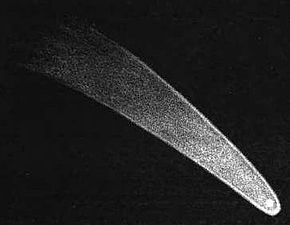
Back Gran cometa de 1811 Catalan Velká kometa roku 1811 Czech C/1811 F1 (Großer Komet) German Gran Cometa de 1811 Spanish C/1811 F1 French Grande Cometa del 1811 Italian Lielā komēta 1811. gadā Latvian/Lettish Komet Besar 1811 Malay Grote Komeet van 1811 Dutch Den store komet av 1811 NB
 The Great Comet of 1811, as sketched by William Henry Smyth | |
| Discovery | |
|---|---|
| Discovered by | Honoré Flaugergues |
| Discovery date | March 25, 1811 |
| Designations | |
| 1811 I, Great Comet of 1811 | |
| Orbital characteristics | |
| Epoch | 1811-Sep-05 2382760.5 |
| Observation arc | 505 days (1.38 years) |
| Number of observations | 1000 |
| Orbit type | Long period comet |
| Aphelion | 423 AU |
| Perihelion | 1.04 AU[1] |
| Semi-major axis | 212.4 AU |
| Eccentricity | 0.995125 |
| Orbital period | 2742 years (inbound) 2974 years (outbound)[2] |
| Inclination | 106.9° |
| Last perihelion | September 12, 1811 |
| Next perihelion | ≈48th century |
| Physical characteristics | |
| Dimensions | 30−40 km[3] |
The Great Comet of 1811,[4] formally designated C/1811 F1, is a comet that was visible to the naked eye for around 260 days, the longest recorded period of visibility until the appearance of Comet Hale–Bopp in 1997. In October 1811, at its brightest, and when it was 1.2 AU from Earth, it displayed an apparent magnitude of 0,[5][6] with an easily visible coma.
- ^ Cite error: The named reference
jpldatawas invoked but never defined (see the help page). - ^ Cite error: The named reference
barycenterwas invoked but never defined (see the help page). - ^ Cite error: The named reference
primerwas invoked but never defined (see the help page). - ^ Jean-Michel Faidit, "La comète impériale de 1811", Les Presses du Midi, 2012; Friedrich Wilhelm Argelander, Ueber die Bahn des grossen cometen von 1811, (Tr. Table of the path of the great comet of 1811) 4, Konigsberg, 1822.
- ^ Cite error: The named reference
greatwas invoked but never defined (see the help page). - ^ Cite error: The named reference
Ramseywas invoked but never defined (see the help page).